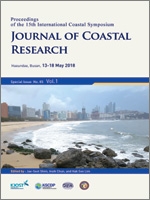Kim, H.-J. and Suh, S.-W., 2018. Improved hypothetical typhoon generation technique for storm surge frequency analyses on the Southwest Korean Coast. In: Shim, J.-S.; Chun, I., and Lim, H.S. (eds.), Proceedings from the International Coastal Symposium (ICS) 2018 (Busan, Republic of Korea). Journal of Coastal Research, Special Issue No. 85, pp. 516–520. Coconut Creek (Florida), ISSN 0749-0208.
In coastal disasters storm surges accelerate damages. To establish appropriate countermeasures, a probabilistic approach to storm surge prediction is required, particularly in case of the historical record of cyclone populations is slim. Among historical typhoons that affected the southwest coast of Korea, some arrived by passing through the Yellow Sea after landfall on southeast mainland China. This study aims to incorporate resurgence and the mid-latitude transition effect to generate more realistic synthetic storms. Synthetic typhoon simulations and surge analyses were performed by taking probability density function parameters from historical storm data, and the simulations were automated as batches using the Perl script. The results showed that the proposed synthetic generation scheme, which models the resurfacing effect, can produce realistic storm frequency results for the Korean coasts. This work can be applied in further vulnerability analyses of coastal zone management.





